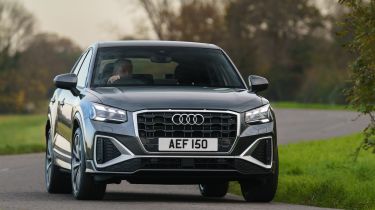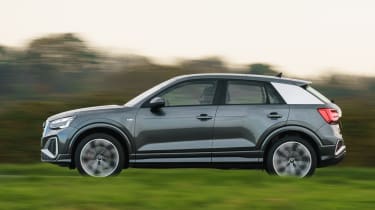Audi Q2 - Engines, performance and drive
Plenty of advanced, efficient engines. Drive can be fun, but bigger wheels and sports suspension make it bumpy

Under the skin, the Audi Q2 is based on the VW Group’s scalable MQB platform. It’s the older MQB A1 version so it’s the same platform used on the old Audi A3 and Volkswagen Golf, despite a lifted ride height, it’s no surprise to find the Q2 drives in a similar way to its hatchback cousins.
Audi uses the phrase ‘go-kart feel’ to describe the Q2, a phrase it’s borrowed from MINI. Turn into a corner and you’ll find the Audi is poised and stable, but the steering lacks the weight and feedback of a BMW X1. It is quick, helping boost the feeling of agility, but the Q2 relies heavily on driver aids and the torque vectoring system is particularly intrusive. The Audi also has a firm ride. It never becomes crashy, but the car follows bumps that more comfortable rivals manage to filter out.
The Q2's steering comes from the old Audi S3 model and it feels meaty enough to put a smile on your face. It's not too heavy, making it an easy car to drive around town and in spite of the car’s short wheelbase and high centre of gravity, there’s not too much body roll when you go around corners – helped by the car’s wide track. The raised driving position makes it easy to place around town, but the pedals sit near to you in a more typical SUV style, which might not be to the tastes of those looking for a sporty feel. This is where the similarly-priced but larger Cupra Formentor feels like a much more focused offering with its more reclined hatchback-like position.
Used - available now
The steering is fast and light, with a consistent weight. There’s very little communication from the chassis, though, while the systems sometimes feel as if they hold the car back in corners, fighting what you’re asking it to do.
The trade-off for this nimble handling is a very firm ride. On bumpy roads the Q2 doesn’t strike the same balance as a Mazda CX-30, for example. It feels firmer and less composed over rippled surfaces, which means that although it handles well thanks to the firmer set-up, it does get disturbed more by mid-corner bumps and doesn’t have the same level of compliance as the CX-30 when the chassis is loaded up. It responds to rippled surfaces more abruptly than the CX-30, too, so isn’t as refined when cruising.
Alongside the more knobbly ride there are one or two other factors that mark down the Q2. For example, the brake pedal feels far too sensitive, which sometimes makes it difficult to bring the car to a smooth stop.
The range-topping, all-wheel drive SQ2 offers predictable, usable performance in all conditions; 0-62mph takes just 4.9 seconds and it has buckets of in-gear shove. The car can shuffle power around its four wheels – up to 100 per cent to the rear wheels if needed – but it's not as playful as some of the best hot hatchbacks on sale. However, if outright pace is more of a concern, the SQ2 is a great choice.
Although much of the Q2 tech is on the options list, there’s plenty of advanced safety kit as standard. Audi’s pre sense safety kit is standard, which includes Autonomous Emergency Braking and will also put the anchors on if it spots a pedestrian stepping out in front of the car.
Engines, 0-60 acceleration and top speed
The 1.0 TFSI has been taken from other cars in the VW Group stable and serves up 109bhp here; that’s almost as much as the (now discontinued) 1.6 TDI model, but engine refinement is stronger, and with a turbo to boost the output, the potential for decent performance and economy in daily use is good. The 1.0-litre revs smoothly, but feels strangled at the top end, although the trade-off is that the turbo delivers decent torque in the middle of the rev range.
The 1.5 TFSI is sweet revving and quiet when you’re cruising on the motorway. It’s also got enough firepower to fulfil the car’s sporty brief. The engine is available with a six-speed manual gearbox or a seven-speed S tronic dual-clutch automatic across all trim levels, although you’ll pay a marginal penalty in CO2 emissions and economy if you opt for the auto. Even so the S tronic gearbox is an excellent choice as it’s quick to react and works smoothly, even when you kick down. And you can take control yourself with paddles behind the steering wheel, although they’re small, plasticky and never deliver rapid-fire changes.
While that’s not exceptional, you’ll find that in most situations the Audi will comfortably keep pace with traffic. Better still, maximum torque is delivered at just 1,500rpm, so you don’t have to extend the rather gruff and thrashy engine to make decent progress. But, while our car’s six-speed box had a generally slick action, our testers found that engaging sixth gear often required some serious muscle. The S tronic gearbox is a nicer partner – this dual-clutch seven-speed unit reacts quickly and smoothly and can be given a sportier bent if you select the optional Audi drive select system.













